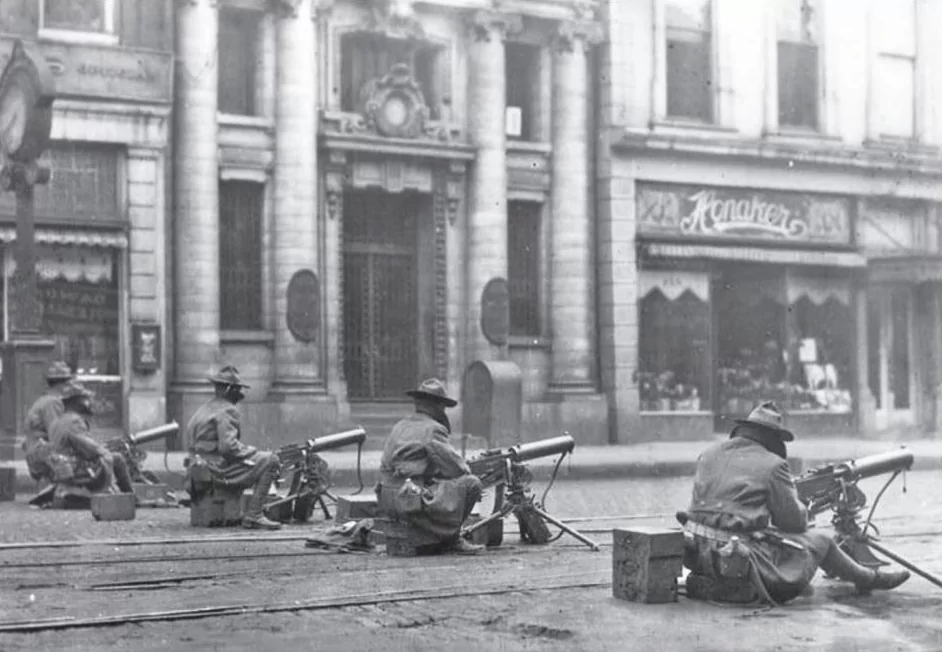“Second Battle of Lexington” Part One: Judge asks citizens to hunt girl’s killer in county

Lexington, Ky., February 4, 1920–The cold, crisp air of February hung heavy in the quiet community of South Elkhorn, in Fayette County, Kentucky. The residents went about their daily routines, bundled up in warm coats and scarves to protect against the icy winds, unaware of the tragedy that was about to unfold.
As the sun began to rise, a scream echoed through the fields, shattering the silence. The people of South Elkhorn rushed to the source of the disturbance, only to find a grisly scene. A young girl lay murdered in the grass, her head battered and broken.
The town was in shock. Who could have committed such a heinous crime in their peaceful community on a cold winter morning? The Lexington Police Department’s Captain Volney Mullikin, a seasoned lawman, was called from his sick bed to track the killer. He brought with him his trusty bloodhounds, trained to sniff out the scent of any fugitive.
Prior to Mullikin’s arrival, a separate posse of men wielding shotguns, pitchforks, and clubs formed to hunt the killer, as well. Among the group were members of the murdered young girl’s family. As the posse set off into the frosty morning, the people of South Elkhorn held their breath, praying that the killer would be brought to justice.
If the law reached the suspect first, they were sure to have their hands full protecting him from the growing civilian posse who sought him. If the posse found him first, extrajudicial “mob justice” was all but a foregone conclusion. The hunt was on.

Law catches suspect first, narrowly eludes lynch mob
Dr. Collette, Policeman White, and Marion Howard were hot on the trail of the suspect, determined to bring him to justice. They searched the vicinity of Keene, suspecting their man may have taken refuge there.
Just on the outskirts of Keene, they finally caught sight of the suspect. He was huddled in an alleyway, shivering and trying to escape the cold. The three men moved in to make the arrest, their guns drawn.
Policeman White and Marion Howard quickly handcuffed the suspect and hustled him into a waiting car. They raced off just as a lynch mob arrived, baying for the suspect’s blood.
The three men breathed a sigh of relief as they drove away, knowing that they had narrowly avoided a violent confrontation. They delivered the suspect to the authorities, praying that justice would now be served.
There were two jails in Fayette County at the time, the City Jail, for crimes committed within city limits, and the County Jail, for crimes committed in the county. Strangely, the County Jail was located in the city, and the City Jail was located in the county.1
That meant the man would have been headed for downtown Lexington under normal circumstances. However, fears of mob violence grew as Chief of Police Jere Reagan publicly described the crime as “the most gruesome Fayette County has ever seen.”
The suspect, Will Lockett, was transferred to the state prison in Frankfort for his own safety. A mob formed at the Fayette County Jail on Short Street and wouldn’t leave until the jailer allowed them to search the building for Lockett.
The mob still attempted to reach him at the penitentiary, but he was guarded by 200 troops with automatic weapons.



Lockett’s trial was scheduled for the coming Monday in downtown Lexington. The Lexington Leader treated his guilt as a foregone conclusion, and even published his alleged confession. (The paper’s owner, John G. Stoll, would serve as jury foreman in the trial.)
Lexington authorities prepared for the worst, with the governor ordering in state troops to keep the peace during the trial. But as the palpable tension in downtown grew, doubts began to form as to whether even their best efforts would be enough to protect Lockett from the mob. The morning of the trial started out peaceful enough, if not eery, with state troops lining Main Street with machine guns. But at 9:28 a.m. the calm was broken as a shot rang out.
To be continued…

References
Girl Murdered By Man In County. (1920, February 4). Lexington Leader, pp. 1–2.
Lockett Indicted, Will be Tried Monday. (1920, February 5). Lexington Leader, pp. 1, 3.
The Murder of Geneva Hardman and Lexington’s Mob Riot of 1920 by Peter Brackney | Jan 20, 2020
The newspaper articles reprinted here were published prior to 1927 and are therefore public domain.
Top photo: Machine gunners with the Kentucky National Guard line up on Main Street towards the mob. Kentucky National Guard eMuseum
Recommended Posts

Let’s start paying Lexington Councilmembers $100K per year to attract better candidates
Thu, October 17, 2024









